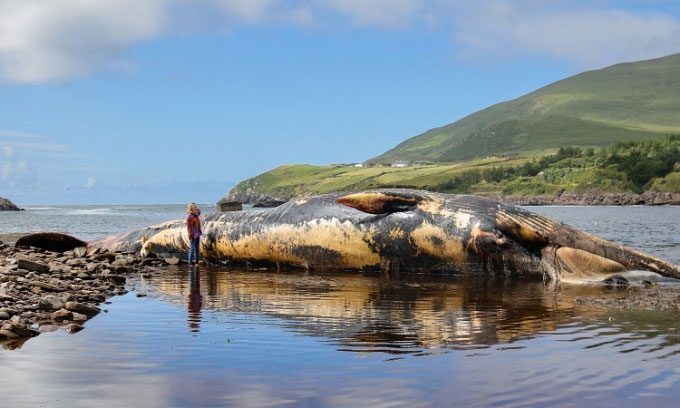Experts Halt Autopsy of Beached Fin Whale After Hearing Gurgling Sounds from Its Gut, Revealing Risk of Explosion if Dissected.
The fin whale (Balaenoptera physalus) measuring 19 meters washed ashore at Baile Uí Chuill Strand in County Kerry, Ireland on July 9. The cause of death remains unclear, but it is likely that the massive whale died approximately three weeks prior to washing up, based on the level of decomposition.

The 19-meter fin whale carcass in Kerry on July 9. (Photo: IWDG)
A team of experts from the Irish Whale and Dolphin Group (IWDG) arrived at the scene to collect samples for examination but were forced to stop due to fears that the carcass could explode. “I was able to take blubber, the jawbone, and skin,” said Stephanie Levesque, an IWDG official. “I was about to take a muscle sample when I heard a sound, as if it was going to explode right in front of me if I went in any deeper.”
When whales die, their intestines fill with methane gas, causing the carcass to swell like a balloon, floating on the surface of the sea until it washes ashore. At sufficiently high concentrations, when mixed with oxygen in the air, methane can cause a whale to explode instantly if pressure increases or when the carcass is dissected, although such occurrences are extremely rare.
In 2013, a marine biologist in the Faroe Islands narrowly escaped when a sperm whale (Physeter macrocephalus) that had washed ashore exploded while the scientist was performing a necropsy. In 2019, another whale exploded at sea off the coast of California.
Sometimes, wildlife authorities deliberately detonate beached carcasses filled with gas to prevent them from decomposing slowly and emitting foul odors. One of the most famous cases occurred in 1970 when a 14-meter sperm whale washed up in Florence, Oregon, was blown apart with half a ton of dynamite.
Typically, around 1 to 2 fin whales wash up on the shores of Ireland each year. There are approximately 100,000 fin whales worldwide, but the species remains vulnerable due to threats such as climate change, plastic pollution, and overfishing of the mollusks, their favorite food, according to the International Union for Conservation of Nature (IUCN). In January 2022, nearly 1,000 fin whales were photographed feeding on a massive aggregation of mollusks in Antarctica.


















































